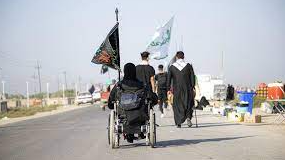Al-Husayn (A): Not Merely a Martyr, but a Living Icon of Justice and Dignity
In the Name of Allah, the Most Gracious, the Most Merciful
Introduction:
When we reflect on the presence of Imam al-Husayn (peace be upon him) in the collective consciousness of the ummah, we are not merely observing an annual commemoration. Rather, we are tracing an emotional current and an evolving communal awareness that has grown steadily across generations—deeply rooted in the conscience of nations and firmly embedded in religious, social, and cultural memory.
Imam al-Husayn (A) was not merely a martyr; he is a living symbol of justice and dignity in the face of tyranny. The impact of his revolution is not to be measured by battles fought or visible losses, but by the degree to which it has been imprinted on identity and conscience.
1. Al-Husayn in Religious Consciousness: The Imam, Not Merely the Hero
Imam al-Husayn's presence in the religious consciousness of the Muslim ummah—particularly within the school of Ahl al-Bayt (A)—goes beyond the image of a heroic figure or moral exemplar. He is:
-
A divinely appointed Imam, whose revolution derives its legitimacy from his divine position within the line of Imamate.
-
A sacred martyr, embodying the pinnacle of devotion and submission to God.
-
A reformer who revived the soul of the ummah after it was suffocated by despotic rulers.
As articulated in the well-known Ziyarat:
"Peace be upon you, O inheritor of Adam, the chosen of Allah... Peace be upon you, O inheritor of Muhammad, the beloved of Allah."
This reveals that Imam al-Husayn (A) is not merely a descendant of the Prophet, but a living continuation of the entire divine prophetic project.
2. Ritual Commemoration: Al-Husayn Lives in Tears and Processions
The ritual expression of mourning is one of the most striking manifestations of Imam al-Husayn’s enduring presence:
-
Majalis (gatherings) that recount and revive his story and mission.
-
Pilgrimage rites, especially the Arbaeen walk, now a globally recognized human phenomenon.
-
Elegies and lamentations that connect children, scholars, and intellectuals to Imam al-Husayn on a deeply emotional and spiritual level.
Importantly, these rituals have not remained empty ceremonies. In many of their forms, they have become living memory and resistance consciousness—fueling moral resolve against injustice.
This is why we witness believing Shia communities—ignited by the fire of Husayn’s revolution—standing firmly against the most oppressive global forces, particularly America, the Zionist regime, and their regional allies. The recent confrontation between the Islamic Republic of Iran and the Zionist entity, backed by the West, is a clear testament. The Shia of Husayn struck Tel Aviv with precision, demolished their corrupt strongholds, elevated the pride of Muslims, and emerged from the conflict with a manifest victory and dignity for the faithful.
3. Al-Husayn: A Unifying and Enlightening Force Across Sects and Nations
Although historically associated with the Shia tradition, the figure of Imam al-Husayn (A) transcends sectarian boundaries and has become a universal point of convergence:
-
Sunni scholars throughout history mourned his martyrdom and regarded him as a beacon of guidance.
-
Thinkers across the Muslim world saw in him a reviver of conscience.
-
Even non-Muslim advocates of justice have seen in Karbala the epitome of true sacrifice.
Thus, Imam al-Husayn becomes more than a sectarian symbol—he is a universal cause that embodies enlightenment, justice, and freedom.
4. Al-Husayn’s Political and Social Impact: A Model of Resistance and Liberation
In nearly all modern liberation movements within the Muslim world, the memory of Karbala has served as a common thread:
-
From the Islamic Revolution in Iran to uprisings against dictatorships and resistance to colonialism, the name of al-Husayn (A) has been ever-present.
Not as a mere slogan, but as a methodology and a source of legitimacy.
Imam al-Husayn taught the ummah that silence in the face of oppression is betrayal, and that sincere blood can triumph over the sword.
In political discourse, al-Husayn now represents:
-
Popular legitimacy,
-
Prophetic leadership,
-
And a state rooted in values—not interests.
5. Al-Husayn in Arts, Literature, and Cultural Consciousness
The story of Karbala introduced to the ummah a unique blend of beauty and tragedy, profoundly influencing:
-
Poetry, as in the grief-stricken verse of Da‘bal al-Khuzā‘ī:
“O Fatima! If you had only seen al-Husayn... slain, thirsty by the Euphrates’ edge.”
-
Visual arts, oratory, and dramatic reenactments that have made Karbala a cornerstone of popular religious expression.
-
Spiritual literature, which sees al-Husayn as a paragon of divine love and self-sacrifice.
This cultural influence has shaped the aesthetic taste of entire societies, making Karbala not just a story, but a foundational part of their emotional and spiritual identity.
In Conclusion:
The personality of Imam al-Husayn ibn Ali (peace be upon him) encompasses:
-
The divine human being,
-
The spiritual Imam,
-
The social reformer,
-
The moral exemplar,
-
And the civilizational symbol.
His revolution was not a fleeting event, but a continuously renewing movement from which generations draw their noblest meanings of existence.
Imam al-Husayn (A) proved that truth never dies, that values are never defeated, and that when blood is shed for the sake of God—it revives nations, shapes civilizations, and forges a new kind of human being.
— Written by Ayatollah Sayyid Fadhil al-Mousawi al-Jabiri

